The image processing software has been developed such that the tea tasters (or planters) can train the system with their own grading. The system estimates/predicts the score/colour index value of any unknown sample against the created matrices. The user-friendly software has been developed to store the tea taster’s results after embossing date-time stamping, tasting ID and pointer to the corresponding image in the image database for future reference.
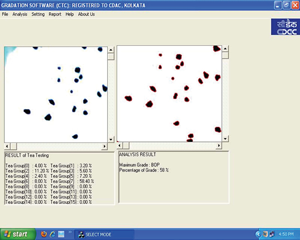
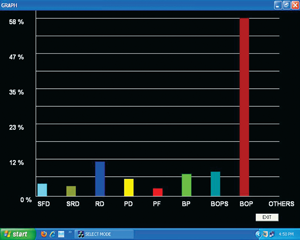
Granular gradation of tea by e-vision. Instant estimation of manufactured tea grade at drier-mouth is one of the desirable requirements for quality tea production. It is very difficult to find out the percentage of tea grade at the drier output at any moment of time. An innovative image processing-based solution has been developed to determine the percentage of various tea grades at drier-mouth output as an estimation of consistency in quality tea production (Figs 7(a) and 7(b)).
[/stextbox]
[stextbox id=”info” caption=”INNOVATIONS”]
3. Electronic tongue for taste comparison
Electronic tongue (e-tongue) is an instrument that measures and compares tastes. In a human tongue, chemical compounds responsible for taste are perceived by human taste receptors. In an e-tongue, sensors detect the dissolved compounds. Like human receptors, each sensor has a spectrum of reactions different from the other. The information given by each sensor is complementary and the combination of all sensor results generates a unique fingerprint.
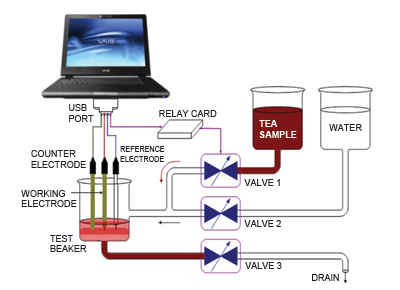
Most of the detection thresholds of sensors are similar to or better than human receptors’. In the biological mechanism, taste signals are transducted by nerves in the brain into electric signals. E-tongue sensors’ process is similar. These generate electric signals as potentiometric variations. Taste-quality perception and recognition is based on building or recognition of activated sensory nerve patterns by the brain on the taste fingerprint of the product. This step is achieved by the e-tongue’s statistical software which interprets the sensor data into taste patterns.
The type of taste that is generated is divided into five categories—sour, salty, bitter, sweet and umami (delicious). Sourness, which includes hydrochloric acid, acetic acid and citric acid, is created by hydrogen ions; saltiness is registered as sodium chloride; sweetness by sugars; bitterness, which includes chemicals such as quinine and caffeine, is detected through magnesium chloride; and umami by monosodium glumate from seaweed and disodium in meat, fish and mushrooms.
The mechanisms for taste recognition in human and electronic tongues have the same three levels:
1. Receptor level: Taste buds in humans and lipid membrane or novel metal sensors in the e-tongue
2. Circuit level: Neural transmission in humans and transducers in the e-tongue
3. Perceptual level: Cognition in the thalamus in humans and statistical analysis by software in the e-tongue
Receptor level. To detect dissolved organic and inorganic compounds, the sensor-probe assembly is used by the e-tongue at the receptor level. Each probe shows cross-sensitivity and selectivity so that each sensor could concurrently contribute to the detection of most substances found in the liquid matrix. These sensors are composed of an organic coating sensitive to the species to analyse the samples and a transducer that allows conversion of the membrane response into signals that will be analysed
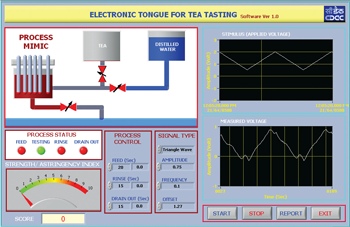
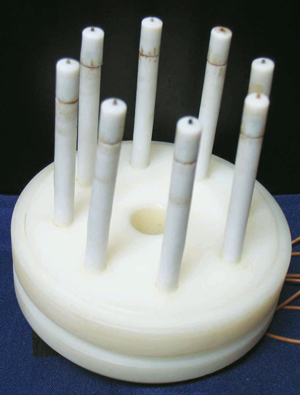
Circuit level. At the circuit level, the sample is quantified and digitised, and results recorded. Electro-analyical methods can be used for measuring the result. These include both active and passive to study an analyte through the observation of potential and/or current.
Potentiometry measures the potential of a solution between two electrodes passively, without affecting the solution much in the process. Voltammetry applies a constant and/or varying potential at an electrode surface and measures the resulting current with a three-electrode system. Coulometry uses applied current or potential to completely convert an analyte from one oxidation state into another. In this experiment, the total current passed is measured directly or indirectly to determine the number of electrons passed
Perceptual level. Perception is done in the computer using the e-tongue system. Depending upon the application for which it is applied, the data analysis can produce a variety of information. Exploratory data analysis can be performed using different statistical methods such as principal component analysis and linear discriminant analysis on the data set to correlate the collected data.
Tea tasters usually evaluate tea quality and conventionally assign scores on a scale of 1 to 10 depending on the major quality attributes of the tea sample. The major quality attributes of black tea are briskness/strength, flavour, aroma and colour.





